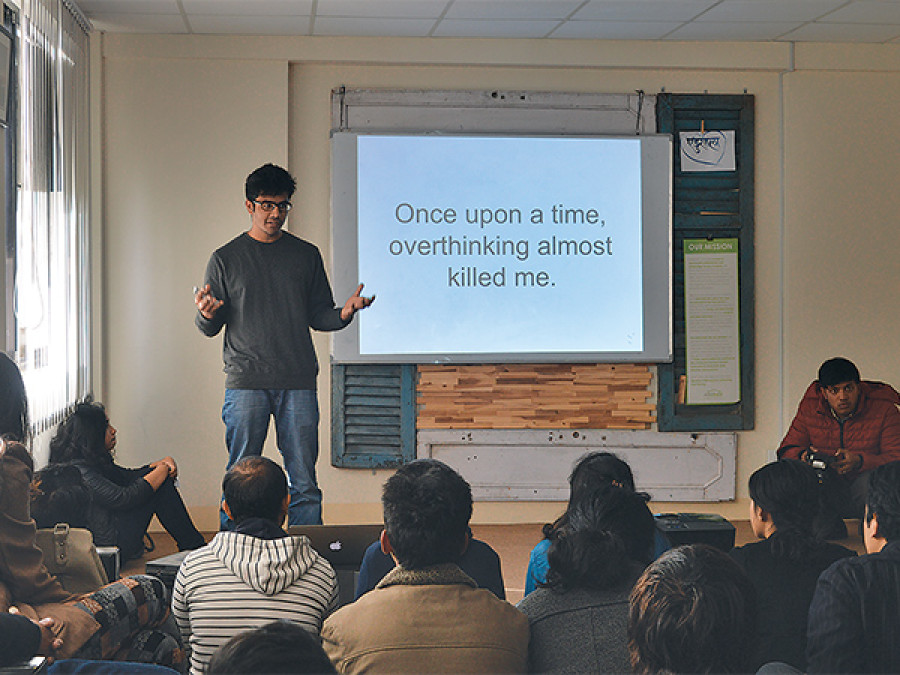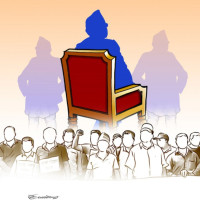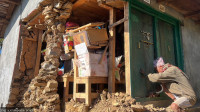Opinion
An art called presentation
Like acting, public speaking also incorporates performance and a knack for telling stories
Deepesh Paudel
While acting, one always has in hand the façade of a character that is being portrayed to camouflage the actor’s own presence, either on the stage or in front of the camera. However, in case of presentations, there are no such layers, leaving the presenter raw and naked. This fear of public speaking, or presentation, is a strong fear that grapples most human minds. Even the greatest of speakers have often overtly admitted their fear of speaking in public. The ‘butterflies in the stomach’ feeling is a common phenomenon in all who have tried their hand at public speaking or presentations. However, channeling the potential energy of those butterflies into kinetic energy or letting it grow into sheer nervousness depends on craft and serious practice. The fear of speaking
in public is not a big deal, but overcoming and conquering this fear is definitely difficult.
Artistic analogy
A performance factor exists in both forms of expression—acting and presentation. This can be considered to be their primary commonality. Public speakers and presenters, like actors, need to own the stage in order to effectively put across their message to the audience. To engage and hold the attention of a diverse audience is one of the challenges that performers have to encounter, irrespective to their genre of performance. Likewise, non-verbal cues transmitted by the performer carry great significance while considering the impact of the performance. Such gestures and body language are often underscored during acting. For instance, there is more emphasis placed on profound emotions, facial expressions, and body movements while acting than while speaking in public or during presentations. But, to undervalue cues like stance, movement, hand-eye coordination, and expressions while making presentations would be a misjudgement. A presenter standing in front of an audience with their hands in their pockets or folded across the chest will straightaway leave a weak impression on the audience.
Similarly, dialogues are the heart of acting. They help express feelings by converting them into an easily understandable form. However, the quality and essence of the content of a dialogue can only be communicated through proper speech delivery. In fact, this has been a common disappointing factor for many Nepali filmgoers. Comments heard from filmgoers after an average Nepali movie generally concerns the weak and uninspired delivery of the dialogue, which can often feel unnatural. Similarly, dialogue is equally integral to public speaking and presentations. The ability of a speaker/presenter to use speech intonation as per the emotion, situation, and subject matter can amplify the audience’s interest and subsequently, motivate and inspire them. Just as every act has a story, every presentation needs to have one too.
The core message coated with a story, however, needs to be succinct and powerful. Expressing oneself through humorous anecdotes, tales of struggle, and success stories can leave a powerful imprint on the minds of the audience. Nevertheless, it is also crucial to be certain about the pace of storytelling in a presentation. Too much elaboration and telling multiple stories at one go
can bore the audience. This often the complaint from audiences who find such instances films to be slow and unnecessarily long. Therefore, despite fundamental differences between acting and presenting, with all these factors in hand, we can draw many similarities between these two genres of
performing art.
Exploring new forms
Recently, every Wednesday, a group of enthusiastic youths gather at Edushala in Pulchowk to share, learn, and inspire. Aiming to master the art of presentation and public speaking, these youths consistently deliver presentations on various socially-relevant issues. After each presentation, the audience gives feedback to the presenter regarding the content and delivery of their presentation. Through these interactions and discussions, the audiences are induced and encouraged to give positive and constructive criticism.
Following this, Prashanta Manandhar and Umes Shrestha, the presentation gurus of the programme, provide valuable comments on the design, content, delivery, and other technicalities of presentations. Key presentation issues, like ‘Death by PowerPoint’, ‘Say No to Bullets’, ‘Respect Your Audience’, and ‘Own the Stage’, are rigorously discussed at every session. Such an interactive atmosphere provides aspiring presenters and speakers with a new avenue to explore social issues while also improving their public speaking skills. Under the tagline, ‘We’re here not to prove but to improve’, #PresentationStuffs has been able to generate overwhelming response by providing a learning platform for students and professionals.
My experience with #PresentationStuffs has been remarkable. As a theatre artist, it feels great to see people engaged in a variety of meaningful performances in front of an audience. The shift from the traditional classroom lecture-style presentation to an artistic performance-based presentation is indeed exhilarating to witness. Evolving from a ‘read-the-slides’ style of presentation, this modern approach to presentations demands passion and showmanship from the presenter. And, the use of creativity has also changed the existing definition of presentation. Shades of theatrical monologues, stand-up comedies, and slam poetries incorporated in presentations add new dimensions and flavour to this form of art. Such theatrical strokes in a presentation create visual appeal for the audience, making them more receptive to novel ideas and methods of delivery. After all, a presentation is a story and the presenter a storyteller.
Paudel is associated with Sarwanam Theatre as a theatre artist and director and can be reached at [email protected]




 11.12°C Kathmandu
11.12°C Kathmandu










